| 17
Residences Take Home the 2009 AIA Housing Award
Summary: Recognizing
project in four award categories—One/Two Family Custom Housing,
One/Two Family Production Housing, Special Housing, and Multifamily
Housing—the AIA Housing Awards jury announces 17 recipients
for 2009. The AIA Housing Awards Program, now in its ninth year,
was established to recognize the best in housing design and promote
the importance of good housing as a necessity of life, a sanctuary
for the human spirit, and a valuable national resource
One/Two Family Custom Housing
The One and Two Family Custom Residences award recognizes outstanding
designs for custom and remodeled homes for specific client(s).
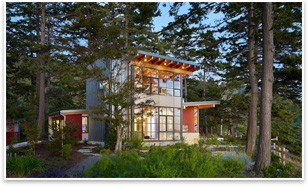 Chuckanut Drive Residence Chuckanut Drive Residence
Bellingham,
Wash.
The Miller | Hull Partnership
This 1400 square foot main house and guest house/ garage is located
on a heavily wooded cliff site with views out over the San Juan Islands
of Washington State. The plan orients to major views south down the
coast line and west out to the islands while being careful to stay
outside of the drip line of the dominate Douglas-fir trees.
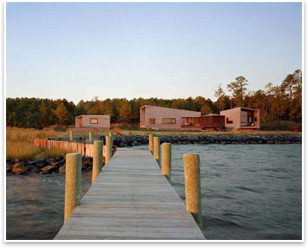 House
on Hoopers Island House
on Hoopers Island
Church
Creek, Md.
David Jameson Architect
The house is used with various degrees of frequency and intensity
depending on the weather and the number of guests. For this reason,
the house is composed of several separate cabins that can be locked
down or conditioned and inhabited as needed. Although the cabins
are individual buildings, they are linked visually by the exterior
metal cladding and coplanar sloped roofs.
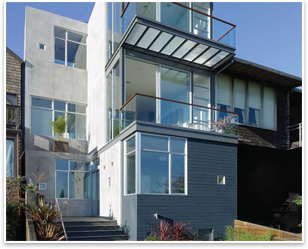 Laidley Street Residence Laidley Street Residence
San Francisco
Zack / de Vito Architecture
The goal of the project was to create a modern, eco-sensitive, urban
retreat that was kid tough and kid friendly. Materials, details and
connections are visible expressions of the design and construction.
This is exemplified in the intricate staircase where water jet-cut
steel stringers support translucent acrylic treads and risers. The
house was designed and built using sustainable design principles.
Energy efficiency, low consumption and low toxicity were key ideas.
 Cinco Camp Cinco Camp
Brewster County, Tex.
Rhotenberry Wellen Architects
The owner desired a retreat that was economically and quickly constructed,
which would cause a minimal impact on the chosen building site. Recycled
shipping containers were chosen as the primary building component
for their compact size and ready availability. Occasional passing
trains are typically loaded with shipping containers, providing a
subtle yet intermittently obvious contextual reference for the use
of containers as a primary building component of the compound.
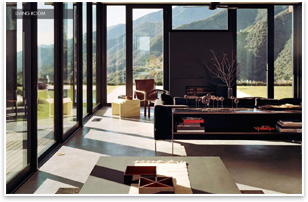 Montecito Residence Montecito Residence
Montecito,
Calif.
Olson Sundberg Kundig Allen Architects
Montecito Residence is a single-family home set in the fire-prone
Toro Canyon. The owners wanted a house that minimized its use of
scarce natural resources and recognized the challenging environmental
conditions of the area. The raised roof functions as an umbrella
to shield the house from the sun, while the long central hallway
allows naturally cool offshore breezes to move through the space.
The hallway also creates an axis dividing the private from the public.
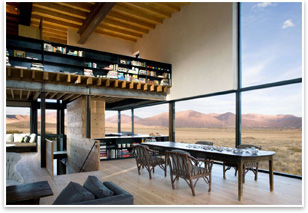 Outpost Outpost
Bellevue, Idaho
Olson Sundberg Kundig Allen Architects
Set in the remote and harsh high desert landscape of Idaho, Outpost
is an artist live/work studio and residence for making and displaying
art. Outpost’s compactness limits site impact and reinforces
the desire to be outside. The architects chose a readily available
construction material—concrete block—for the primary
structure; commercial builders were able to quickly and cheaply assemble
the building. Interiors are exposed and unfinished; there is no waste
in coatings and low to no VOCs.
 Glade House Glade House
Lake Forest, Ill.
Frederick Phillips and Associates
Built in the historic district of Lake Forest, Illinois, and subject
to strict municipal review, this house mediates between the common
and the unexpected. In a community where large traditional houses
prevail, this house seeks a return to simple agrarian forms, colors,
and textures typical to the region, but lost long ago.
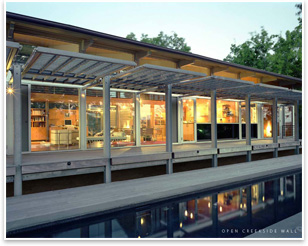 Low Country Residence Low Country Residence
Mount Pleasant,
South Carolina
Frank Harmon Architect
The long, one-room-deep floor plan gives each room windows and porches
overlooking Shem Creek. A modern interpretation of Charleston’s
historic shutters provides protection from harsh weather and summer
sun. Operable windows provide natural cross-ventilation and lighting.
Approaching the house under a canopy of moss-draped live oaks and
up a gentle ramp, the view of the marsh appears like an element in
a Japanese painting.
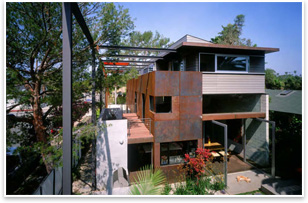 700 Palms Residence 700 Palms Residence
Venice, California
Ehrlich Architects
The objective for this eco-friendly residence in
Venice, California was to: design a high-performance home that
dissolves the barriers between indoors and outdoors; utilize raw,
honest materials appropriate to the bohemian grittiness of the
surrounding community; and have the smallest carbon footprint in
balance with lifestyle. The house design takes full advantage of
the local climate such that a net zero energy building is obtained.
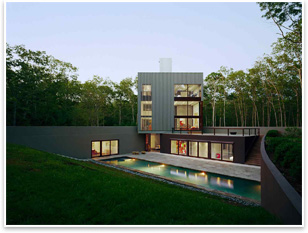 House at Sagaponac House at Sagaponac
Wainscott,
New York
TsAO & McKOWN Architects
A significant issue was how to root the house to the earth; the
nearly flat site in a young growth forest offered no footing. By
reshaping the topography, the architects were able to establish the
first level slightly below grade and sculpted the surrounding terrain
into a gentle rise. The house functions on multiple levels - as much
an intimate retreat for two (or one) as an accommodating host to
an extended family (or numerous guests).
Multifamily Housing
The Multifamily Housing award recognizes outstanding apartment and
condominium design. Both high- and low-density projects for public
and private clients were considered. In addition to architectural
design features, the jury assessed the integration of the building(s)
into their context, including open and recreational space, transportation
options and features that contribute to livable communities.
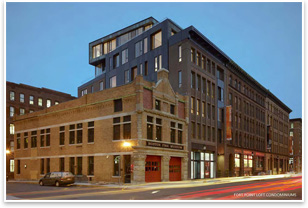 Fort Point Loft Condominiums Fort Point Loft Condominiums
Boston,
Massachusetts
Hacin + Associates, Inc.
This 140,000 square foot project encompasses
the adaptive reuse of two historic structures, the construction
of a new building on an adjacent lot, and a three-story rooftop
addition above all three structures. The program includes 99 condominium
units [with 8 affordable units, including 3 artist live/work studios],
two levels of restaurant/retail and a lobby/art gallery. The new
facade at 346 Congress takes cues from the restored facades at
348 and 354. Together, the three buildings relate to one another
with a progressive series of window groupings, architectural details,
colors, materials and proportional rhythms
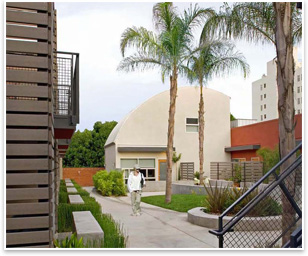 Courtyard Lofts Courtyard Lofts
Long Beach, California
Interstices and Studio One Eleven at Perkowitz+Ruth Architects
Situated
in downtown Long Beach, Courtyard Lofts represents the transformation
of two derelict commercial buildings and an existing parking lot
into residential lofts surrounding a verdant communal courtyard.
As an infill project incorporating the adaptive re-use of two structures,
the low-rise, humane scale of the project is respectful of its
context and preserves the character of the existing buildings and
the surrounding community. The architecture of Courtyard Lofts
was consciously designed to integrate sustainability.
 ICON ICON
San Diego, California
TANNERHECHT Architecture
The project is constructed on a 55,000 square
foot brown-field industrial site and is comprised of 327 residences
in four towers ranging from 5 to 24 stories connected by bridges
and terraces surrounding the contemporary garden. The tallest tower
is topped with the SkyBox overlooking the Petco Park and San Diego
Bay. The architecture preserves and rehabilitates the historic
building facades and penthouse of the Carnation/Qualitee Dairy,
San Diego Historical Site No. 289.
One/Two Family Production Housing
The One and Two Family Production Homes award will recognize excellent
design of homes built for the speculative market.
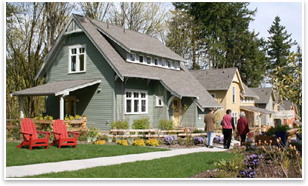 Conover Commons Conover Commons
Redmond, Washington
Ross Chapin Architects
This project was a for-profit venture by an
architect/developer team to demonstrate the market for detached
housing alternatives for small households. It was also intended
as a compelling example of suburban infill residential development.
This project met the 4-Star Rating of the Master Builders Association
BUILTGREEN program, including high-efficiency appliances, heaters
and light fixtures, high-level insulation and weather sealing,
materials selected for resource efficiency, low-toxicity and durability,
and jobsite recycling.
Special Housing
The Special Housing award recognizes outstanding design of housing
that meets the unique needs of other specialized housing types such
as single room occupancy residences (SROs), independent living for
the disabled, residential rehabilitation programs, domestic violence
shelters, and other special housing.
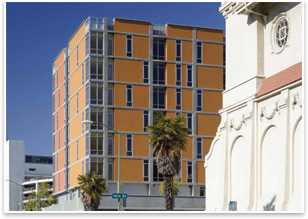 Madison @ 14th Apartments Madison @ 14th Apartments
Oakland,
California
Leddy Maytum Stacy Architects
The building provides 79 apartments
and supportive services for low-income residents and former foster
youth at risk of becoming homeless. The ground floor has retail
space that encourages pedestrian street use in the neighborhood.
The second floor includes a podium garden, community rooms and
shared kitchen. The upper floors house affordable rental units
ranging in size from 400 square foot studios to 1,100 square foot
three bedroom apartments. The residential units are constructed
of materials that are durable, healthy and environmentally sustainable.
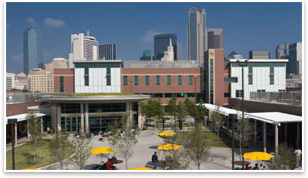 The Bridge The Bridge
Dallas, Texas
Overland Partners Architects
The temporary shelter is a reclaimed
warehouse while transitional housing is on upper floors, separating
disparate populations. Sleeping areas have translucent walls that
welcome natural light and remind the city of the presence and function
of the building.
A publicly-selected artist worked with homeless, superimposing their
writings over brightly colored glass — a metaphor for the spectrum
of humanity. Facing downtown, this is a gift to the community, a
magnet for the homeless, and a source of inspiration.
It proves that shelters should not be isolated, but an integrated
part of our community; they are valuable civic buildings representing
the compassion of our society.
 Saint John’s Abbey and Monastery
Guesthouse Saint John’s Abbey and Monastery
Guesthouse
Collegeville, Minnesota
VJAA
Sited directly on Lake Sagatagan and adjacent to the existing
monastery, the new guesthouse combines conference and meeting areas,
a library, a meditation room, dining facilities, and administrative
offices with thirty guest rooms and suites. The positioning of the
building was organized so that all of the rooms would face the lake.
The project uses environmental philosophies found within the Rule
of Benedict to guide sustainable strategies.
|


 Chuckanut Drive Residence
Chuckanut Drive Residence House
on Hoopers Island
House
on Hoopers Island Laidley Street Residence
Laidley Street Residence Cinco Camp
Cinco Camp Montecito Residence
Montecito Residence Outpost
Outpost Glade House
Glade House Low Country Residence
Low Country Residence 700 Palms Residence
700 Palms Residence House at Sagaponac
House at Sagaponac Fort Point Loft Condominiums
Fort Point Loft Condominiums Courtyard Lofts
Courtyard Lofts ICON
ICON Conover Commons
Conover Commons Madison @ 14th Apartments
Madison @ 14th Apartments The Bridge
The Bridge Saint John’s Abbey and Monastery
Guesthouse
Saint John’s Abbey and Monastery
Guesthouse